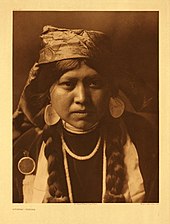
Yakima County is a county in the U.S. state of Washington. As of the 2020 census, its population was 256,728. The county seat and most populous city is Yakima. The county was formed out of Ferguson County in January 1865 and is named for the Yakama tribe of Native Americans.
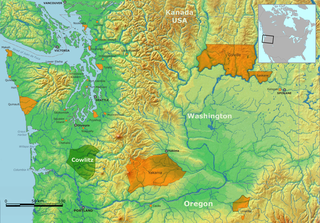
The term Cowlitz people covers two culturally and linguistically distinct indigenous peoples of the Pacific Northwest; the Lower Cowlitz or Cowlitz proper, and the Upper Cowlitz / Cowlitz Klickitat or Taitnapam. Lower Cowlitz refers to a southwestern Coast Salish people, which today are enrolled in the federally recognized tribes: Cowlitz Indian Tribe, Quinault Indian Nation, and Confederated Tribes of the Chehalis Reservation. The Upper Cowlitz or Taitnapam, is a Northwest Sahaptin speaking people, part of the Confederated Tribes and Bands of the Yakama Nation.

Chinookan peoples include several groups of Indigenous people of the Pacific Northwest in the United States who speak the Chinookan languages. Since at least 4000 BCE Chinookan peoples have resided along the upper and Middle Columbia River (Wimahl) from the river's gorge downstream (west) to the river's mouth, and along adjacent portions of the coasts, from Tillamook Head of present-day Oregon in the south, north to Willapa Bay in southwest Washington. In 1805 the Lewis and Clark Expedition encountered the Chinook Tribe on the lower Columbia.
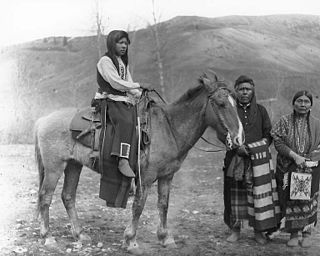
The Palouse are a Sahaptin tribe recognized in the Treaty of 1855 with the United States along with the Yakama. It was negotiated at the 1855 Walla Walla Council. A variant spelling is Palus. Today they are enrolled in the federally recognized Confederated Tribes and Bands of the Yakama Nation and some are also represented by the Colville Confederated Tribes, the Confederated Tribes of the Umatilla Indian Reservation and Nez Perce Tribe.
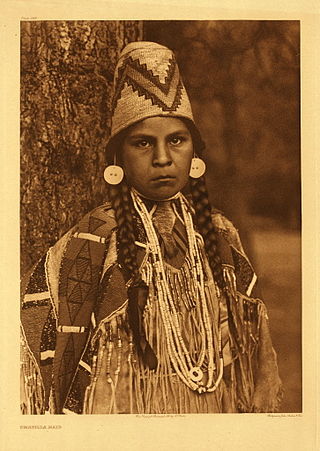
The Umatilla are a Sahaptin-speaking Native American tribe who traditionally inhabited the Columbia Plateau region of the northwestern United States, along the Umatilla and Columbia rivers.
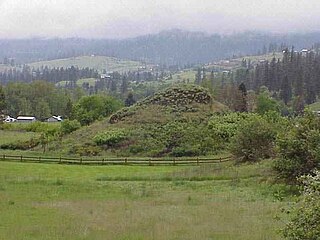
Indigenous peoples of the Northwest Plateau, also referred to by the phrase Indigenous peoples of the Plateau, and historically called the Plateau Indians are Indigenous peoples of the Interior of British Columbia, Canada, and the non-coastal regions of the Northwestern United States.

The Yakima War (1855–1858), also referred to as the Plateau War or Yakima Indian War, was a conflict between the United States and the Yakama, a Sahaptian-speaking people of the Northwest Plateau, then part of Washington Territory, and the tribal allies of each. It primarily took place in the southern interior of present-day Washington. Isolated battles in western Washington and the northern Inland Empire are sometimes separately referred to as the Puget Sound War and the Coeur d'Alene War, respectively.

The Puget Sound War was an armed conflict that took place in the Puget Sound area of the state of Washington in 1855–56, between the United States military, local militias and members of the Native American tribes of the Nisqually, Muckleshoot, Puyallup, and Klickitat. Another component of the war, however, were raiders from the Haida and Tlingit who came into conflict with the United States Navy during contemporaneous raids on the native peoples of Puget Sound. Although limited in its magnitude, territorial impact and losses in terms of lives, the conflict is often remembered in connection to the 1856 Battle of Seattle and to the execution of a central figure of the war, Nisqually Chief Leschi. The contemporaneous Yakima War may have been responsible for some events of the Puget Sound War, such as the Battle of Seattle, and it is not clear that the people of the time made a strong distinction between the two conflicts.

The Klickitat are a Native American tribe of the Pacific Northwest. Today most Klickitat are enrolled in the federally recognized Confederated Tribes and Bands of the Yakama Nation, some are also part of the Confederated Tribes of the Grand Ronde Community of Oregon.
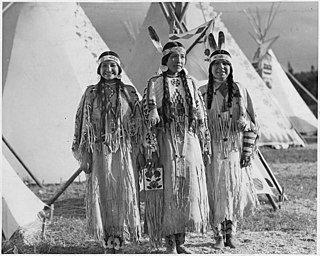
The Sahaptin are a number of Native American tribes who speak dialects of the Sahaptin language. The Sahaptin tribes inhabited territory along the Columbia River and its tributaries in the Pacific Northwest region of the United States. Sahaptin-speaking peoples included the Klickitat, Kittitas, Yakama, Wanapum, Palus, Lower Snake, Skinpah, Walla Walla, Umatilla, Tenino, and Nez Perce.
Sahaptin or Shahaptin, endonym Ichishkin, is one of the two-language Sahaptian branch of the Plateau Penutian family spoken in a section of the northwestern plateau along the Columbia River and its tributaries in southern Washington, northern Oregon, and southwestern Idaho, in the United States; the other language is Nez Perce or Niimi'ipuutímt.
The Wenatchi people or Šnp̍əšqʷáw̉šəxʷi / Np̓əšqʷáw̓səxʷ are Native Americans who originally lived near the confluence of the Columbia and Wenatchee Rivers in Central Washington state. Their language is Interior Salish. Traditionally, they ate salmon, starchy roots like camas and biscuitroot, berries, deer, sheep and whatever else they could hunt or catch. The river that they lived on, the Wenatchee River, had one of the greatest runs of salmon in the world prior to numerous hydroelectric dams being put in on the downstream Columbia, pollution and other issues, and was their main food source.

The Naches River is a tributary of the Yakima River in central Washington in the United States. Beginning as the Little Naches River, it is about 75 miles (121 km) long. After the confluence of the Little Naches and Bumping River the name becomes simply the Naches River. The Naches and its tributaries drain a portion of the eastern side of the Cascade Range, east of Mount Rainier and northeast of Mount Adams. In terms of discharge, the Naches River is the largest tributary of the Yakima River.

Rimrock Lake is a lake along the course of the Tieton River, in Yakima County, Washington state, US.
Ahtanum Creek is a tributary of the Yakima River in the U.S. state of Washington. It starts at the confluence of the Middle and North Forks of Ahtanum Creek near Tampico, flows along the north base of Ahtanum Ridge, ends at the Yakima River near Union Gap and forms a portion of the northern boundary of the Yakama Indian Reservation. The name Ahtanum originates from the Sahaptin language, which was spoken by Native Americans in the region.

The Simcoe Mountains Volcanic Field, sometimes called the Simcoe Highlands, is a group of lava flows and extinct cinder cones located to the east of the Cascade Range in south-central Washington, United States. The mountains lie within Klickitat and Yakima Counties with the northern half making up part of the Yakama Indian Reservation. Although the volcanic field is located near the Cascade Arc of volcanoes, it is an intraplate volcanic field rather than having activity sourced from the Cascadia subduction zone. The last known eruption was about 631,000 years ago.
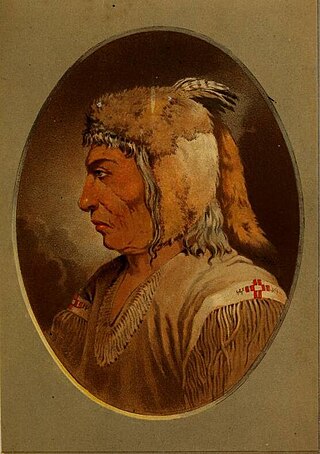
The Skinpah were a Sahaptin-speaking people of the Tenino dialect living along the northern bank of the Columbia River in what is now south-central Washington. They were first recorded as the E-nee-shers in 1805 by Lewis and Clark. Their village, Sk'in, was located adjacent to Celilo Falls in modern day Klickitat County.

The Kittitas are a Sahaptin tribe closely related to the Yakama, sometimes described as a band or subtribe of the Yakama. Their traditional territories are found within Kittitas and Yakima counties within Washington state, chiefly in the Kittitas Valley, Naches Valley, Wenas Valley, and upper Yakima Valley. Individuals of Kittitas descent are today enrolled in the Confederated Tribes and Bands of the Yakima and the Confederated Tribes of the Colville Reservation, but the Kittitas are not recognized as a distinct band by either tribal government.

